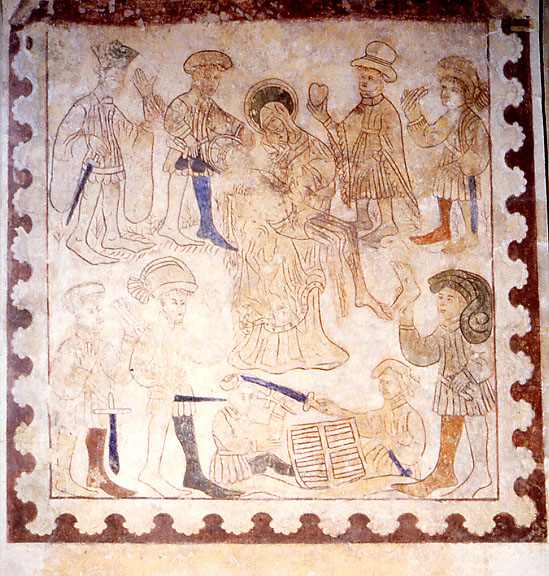Broughton, Buckinghamshire (CCT*) c.1470
The Warning to Swearers

Remaining examples of this subject are rare in England, making it difficult to generalise about what is ‘normal’, but it is probably fair to say that most Warnings to Swearers have a central figure of Christ himself. Here, though, as also in the much more battered example at Corby Glen in Lincolnshire, the central group is a Pietà, with the grieving Virgin holding her badly mutilated (his right leg in particular is shown as broken and incomplete) Son in her lap. Surrounding the two central figures are nine young men, all dressed in the height of fashion.
They hold various items, most of them body parts – from the top right, a handful of bones, next left a heart, extreme left a hand. The remaining figure, third from the right in parti-coloured bright blue hose, may be holding or indicating Christ’s head. The three standing men in the lower half of the painting hold (from right) a foot, a host with a cross on it (unfortunately bleached out of this photograph almost completely) and more bones. At the lower centre, two men sit either side of a backgammon board. One has drawn his sword and strikes the other, who seems to be holding a cross, on the head.
The ‘Warning’ here is directed at those who swear by parts of Christ’s body, or, not much less reprehensibly, sacramental symbols like his Cross or the Sacrament itself. These oaths were obviously commonly heard, not only in the fifteenth century and not only from the lips of fashion-conscious young men, according to all the accounts – King John was evidently heard to swear ‘By God’s feet’ that either he or one of his upstart barons ‘must be King in England’. No doubt other monarchs did much the same. Parish priests inveighed against the blasphemous habit, assuring swearers that their words wounded Christ anew, and they would pay for them in the end – but to little effect, presumably. The association with gaming, as here with the backgammon board, is strong. Chaucer’s Pardoner refers to it – ‘Hasard [dice, or gaming] is verray mooder of lesyinges/And of deceite, and cursed forsweryinges/Blaspheme of Christ, manslaughtre…’¹
The painting is interesting on stylistic grounds, too. The central Pietà, with its sinewy elegance of line, is much more finely painted than the rather clumsy figures of the young men. It may be that this is the work of more than one hand – a master and assistants, perhaps. Or is the central group a careful copy of another, perhaps earlier, painting, woodcut or engraving? To my eye there is a suggestion of that about it.
There are several other paintings at Broughton, including a Doom and a St George and the Dragon now on these pages.
* CCT=The Churches Conservation Trust, successor to the Redundant Churches Fund
¹ Chaucer, Works, ed. Robinson, 1957: The Pardoner’s Tale, 560-562
† in page heading = Diocese